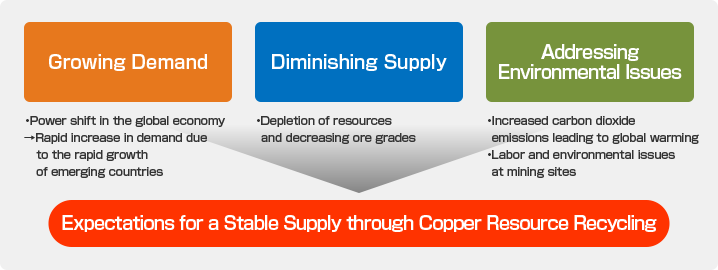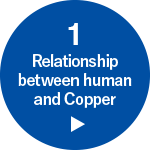LEARN MORE ABOUT US

The first metal used by humans
"Copper" is said to be the first metal utilized by early humans when they began using tools. Around 7000 BC, traces of a site in Anatolia (a region now located in the main part of the Republic of Turkey) suggest that natural copper was already being processed by hammering with stone tools. By around 6000 BC, molten copper produced using charcoal-fired heat was introduced, marking the beginning of the Copper Age and eventually leading to the leap in human civilization known as the "Bronze Age."
The discovery of copper, an easily refined metal with excellent processing ability and durability, brought numerous benefits to humanity, including increased efficiency in hunting, greater agricultural production, and resource development. As a result, population growth and the concentration of wealth accelerated, leading to the emergence of urban civilizations.
Subsequently, in ancient times, the primary material for metal objects such as utensils and weapons shifted from copper to iron. However, in the modern industrial development, the importance of copper has continued to grow with the times.


The diverse characteristics of copper and copper alloys
Copper is a metal with outstanding characteristics such as "malleability," "corrosion resistance," "electrical conductivity," "thermal conductivity," and "antibacterial properties." It is used in various applications and has become an indispensable part of our daily lives.
Characteristic 1
Malleability
Copper has a relatively low melting point, approximately 1,084 degrees Celsius, among metals. This, due to its ability to be melted through combustion processes like using charcoal, led to the utilization of molten copper in prehistoric times. Additionally, copper exhibits excellent ductility, making it easy to undergo plastic processing such as rolling and extrusion. In addition to the aesthetic appeal of the raw material, the ease of such processing is a key reason why "copper statues" and "bronze statues" are widely used in the fields of art and sculpture,
Characteristic 2
Corrosion Resistance
Copper is a metal with exceptional corrosion resistance. When copper comes into contact with oxygen, it forms a protective film of copper oxide on the surface, thus preserving the inner metal.
In the past, copper foils were applied to the hulls of large wooden ships to take advantage of copper's resistance to rust and corrosion caused by seawater. Large vessels like tankers and passenger ships also use screws made from an alloy called "aluminum bronze," where copper is the primary component. Copper, with added elements like aluminum, iron, nickel, and manganese, enhances strength and hardness. It has become an indispensable material for ship screws, and MERF holds an overwhelming share in the production of this aluminum bronze, both domestically and internationally.
Moreover, copper and copper alloys with excellent corrosion resistance are widely used in water-related components in daily life, such as faucet valves and water pipes.
Characteristic 3
Electrical Conductivity
Electrical conductivity (lowest electrical resistance) among metals, with the order of silver > copper > gold > aluminum. Despite being slightly inferior to silver in conductivity (around 94% at room temperature), copper is much more affordable than the precious metal silver. As a result, copper is extensively used in materials requiring strong conductivity, including electrical wires. With the proliferation of personal computers, mobile phones, and the increasing demand for hybrid cars in the automotive industry, the importance of copper in the foundational components of life infrastructure and electronic devices continues to grow.
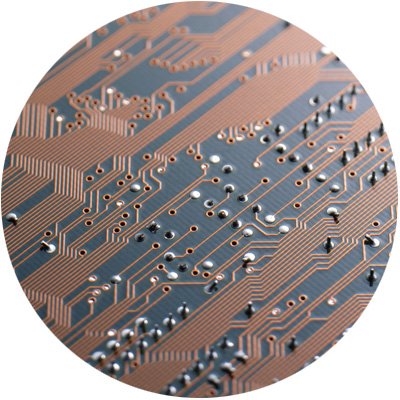
Characteristic 4
Thermal Conductivity
Copper exhibits excellent thermal conductivity, making it suitable for use in the heat exchangers of air conditioners and refrigerators. Additionally, you may have seen high-quality cookware such as pots and pans made of copper. For example, special frying pans used to make Japanese omelets (tamagoyaki) are mostly made of copper. The rapid and uniform transmission of heat minimizes uneven cooking, resulting in a smooth and gentle flavor. In addition to its "antibacterial properties," copper's outstanding thermal conductivity is another reason why it is used in high-end cookware.
Characteristic 5
Antibacterial Properties
Since ancient times, copper has been known as a metal with antibacterial properties. Other metals with strong antibacterial effects include silver, sterling silver, gold, and lead. However, precious metals are expensive, and there is a risk of lead poisoning with lead, making copper the superior choice. Copper and copper alloys are used in everyday items such as doorknobs, handles, and handrails at home, expecting these antibacterial properties.

Why Copper Has Been Widely Used as Currency
Copper and copper alloys have been utilized as materials for currency since ancient times. For example, in the current Japanese currency, except for the 1-yen coin made of aluminum, all other coins are made of copper alloy. This is not only due to its lower cost compared to precious metals like gold and silver but also for the following reasons.
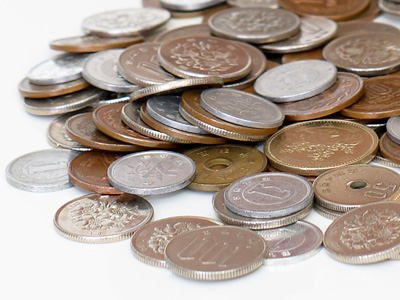
(1) Easy to Process
Copper is a metal that is easily processed through plastic deformation methods such as rolling and extrusion, and it possesses excellent ductility. Copper and copper alloys are suitable metals for mass-producing coins with complex designs.
(2) Resistant to Wear
If you prepare two 1-yen coins and rub them together on the palm of your hand, you will notice that the surface of the 1-yen coin wears off within seconds, leaving your hands stained with dark powder. On the other hand, attempting the same with 10-yen or 100-yen coins, you will find that their surfaces do not wear off easily. The long lifespan of coins, almost semi-permanent, is attributed to the excellent wear resistance of copper and copper alloys.
(3) Resistant to Corrosion
Copper is a representative metal that is resistant to corrosion. The discovery of coins from hundreds of years ago in sunken ships is attributed to this characteristic.
(4) Rich in Color
The beautiful surface and rich color are significant features of copper and copper alloys. While the 10-yen coin closely resembles the natural color of copper, and the 5-yen coin has a more golden hue, metals that exhibit such a golden color among the various types are limited to gold and copper.
(5) Antibacterial Effect
Coins manufactured by the Director of the Mint can circulate for several decades. The use of copper and copper alloys in coins is partly due to the expectation of an antibacterial effect from copper when the coins pass through the hands of many people.

Copper is an indispensable element in daily life and industrial infrastructure
Copper, known as the "blood vessels of industry," plays a crucial role in supporting our modern lives and industrial infrastructure. It performs an essential function that cannot be easily replaced by other metal materials.

The significance of copper recycling
Since ancient times, vast amounts of copper have been extracted from mines around the world for thousands of years, and the demand for copper has been steadily increasing with the passage of time. However, due to factors such as the declining grade in copper mines and environmental issues associated with mining toxins, the option of "mining" as a source of copper procurement is becoming increasingly challenging.
In Japan, there were once large copper mines like the Ashio Copper Mine (located in Tochigi Prefecture) and the Besshi Copper Mine (located in Ehime Prefecture), making it one of the world's leading copper-producing countries. However, all these mines are now closed, and Japan relies on 100% imports for copper ore. On the other hand, copper is a "recyclable metal" that can be perpetually regenerated through recovery and refining.
Amidst the growing demand for copper that has supported human civilization, there is a rising global focus on copper recycling as a means to procure high-quality copper materials and achieve a sustainable society.
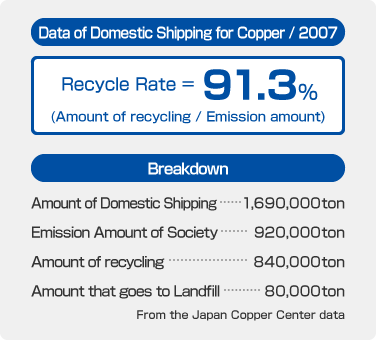
Why is copper recycling gaining attention?
As global demand for copper continues to rise, the diminishing supply and decreasing ore grades, coupled with environmental considerations, have heightened the necessity for copper recycling.
